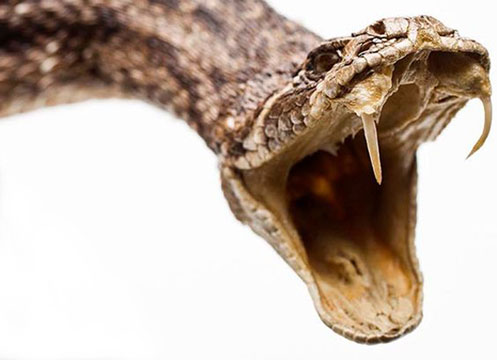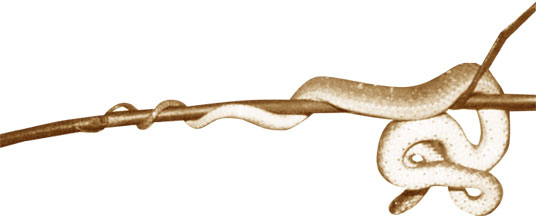Snakebite? Early treatment can save your life
by Carol Aloysius
 Sri Lanka is said to have one of the highest incidences of snake bite
victims per 100,000 population in the world. Being a country whose flora
and fauna has given shelter to some 104 species of both land and sea
snakes, medical experts reiterate that victims of snake bites should not
panic but instead seek early treatment from a recognised hospital where
treatment facilities are readily available and follow the instructions
given them. A delay or experimenting with alternative medicines could
lead to fatal results, they warned. Sri Lanka is said to have one of the highest incidences of snake bite
victims per 100,000 population in the world. Being a country whose flora
and fauna has given shelter to some 104 species of both land and sea
snakes, medical experts reiterate that victims of snake bites should not
panic but instead seek early treatment from a recognised hospital where
treatment facilities are readily available and follow the instructions
given them. A delay or experimenting with alternative medicines could
lead to fatal results, they warned.
The Sunday Observer spoke to one of Sri Lanka’s foremost authorities
on snake bites, Professor of Medicine, Department of Clinical Medicine,
Faculty of Medicine, University of Colombo, Prof. C Ariaranee
Gnanathasan (nee Ariaratnam,) to get more insights into how to recognise
a venomous snake, treatment procedure for victims, and the golden rules
of Do’s and Don’ts to be followed when bitten by a snake.
Excerpts…
Q:What are the most venomous) species in the world? How many
are found in Sri Lanka?
A. There are 2,700 species of snakes recognized around the
world. They belong to 13 different families. Of these only 500 venomous
snakes which possess front fangs are capable of injecting venom. Sri
Lanka has flora and fauna that give shelter to 104 species of land
snakes, and its shores to 15 species of sea snakes. Of these, seven
species are medically important venomous snakes and are distributed
according to the geographical variation in Sri Lanka.
Q:Do all of them live on land? Or are there some which live in
streams and lakes and others in the sea?
A. There are 104 land snakes, 15 species of sea snakes.
Q:Examples?
A. Medically important land snakes are Cobra (Naja naja),
Common Krait (Bungarus caeruleus) Sri Lankan Krait (Bungarus ceylonicus),
Russell’s viper ( Daboia russelli russelli),Saw-scaled viper (Echis
carinatus),
Hump-nosed viper (Hypnale species),Green - pit viper (Trimeresurus
trigonocephalus)
Q:Are all snakes venomous?
A.No. Most of the land snakes in Sri Lanka are harmless and non
venomous. Different species of snakes can be categorized to the
following groups according to the potency of their venom toxicity:
* Highly venomous snakes-
Their venoms cause severe adverse effects in the body of the bitten.
It can cause severe symptoms, adverse clinical conditions and even death
eg. Land snakes of Kraits, Cobra, Russell’s viper and saw scaled viper.
All sea snakes inhabiting the coastal waters of Sri Lanka are highly
venomous. Only 7 species are medically important venomous snakes in SL.
Saw-scaled viper is highly venomous snake in the world, but in SL it
is found in North , East part of the island in the sandy soil, but no
recorded deaths have been reported from it in Sri Lanka.
Q:How do you identify a venomous from a non venomous snake?
A. Unfortunately, there is no simple criterion a person can
use to identify a poisonous snake from a harmless one. None of the
popular criteria such as a broad, triangular head, a heavy body, cat’s
eyes (vertical pupils), a flat body, or rough scales are safe since both
harmless and dangerous snakes are known to share some or all of these
traits. Venomous snakes however have enlarged maxillary teeth which are
called “Fangs”.
The only unfailing method to identify a venomous one is to examine
the snake for hollow of grooved fangs. For obvious reasons, this is not
a practical approach. A better method is to know which venomous snakes
occur in your area and have a good idea about what they look like.
Q:What are the most common land snakes found in populated
urban environments like towns and cities?
A. cobra, hump-nosed viper, common krait etc
 Q:Which live in sparsely populated areas or in jungles and
forests? Q:Which live in sparsely populated areas or in jungles and
forests?
A. Russell’s vipers common krait, cobra.
Q:The saw scaled viper various called veli polonga and surattu
pambu is said to bite and kill more people than any other species of
snakes in the world . Where are these snakes are usually found?
A. The saw-scaled viper (SSV) (E.carinatus in Sri Lanka
inhabits the arid coastal areas of the first peneplain in the dry zone.
The geographical distribution includes the districts of Jaffna,
Mullaitivu, Mannar of Northern Province, the Eastern Province, and parts
of the Southern province such as Yala. The snake is largely nocturnal
and in dry weather it is observed at water holes. During day time it
lies concealed under leaf litter and stones. It strikes with lightening
rapidity, delivers its bite, and returns to the position it occupied
before striking, making one wonder whether the bite had occurred!
There is on-going research
Q:How would you know if a snake bite is venomous or not?
A. Symptoms of a venomous bite are pain, bleeding from the
bite site, discoloration & swelling around the bitten area. These signs,
called local envenoming, are pronounced in a viper bites and cobra than
in krait bite.
If the venom has entered the circulation then patient could develop
signs and symptoms of spontaneous bleeding, neurological features like
drooping of the eye lids, double vision, difficulty in breathing and
weakness of the muscles, even acute kidney failure later on, depending
on which snake has bitten him or her.
The venom composition will vary for different species of snakes, some
snakes like cobra, kraits causes mainly affects the nervous system of
the body, some snakes like Russell’s viper mainly affects the blood
clotting mechanism hence causes spontaneous bleeding from anywhere in
the body including brain. These are called systemic envenoming.
Russell’s viper and Hump-nosed vipers are known to cause acute kidney
failure in Sri Lanka.
Q:First aid for a snake bite /
A. Let me start with what NOT to do.
Do not panic. Do not make any cut, scratch or incision with a razor,
knife or any other sharp object at bite site or any where else because
they cause introduction of infection, damage to important anatomical
structures and severe bleeding if your blood is non clotting.
Do not suck at the wound with your mouth or any suction apparatus. Do
not apply ice packs to the bitten area.
Do not apply electric shocks to the bite or anywhere else!
Do not use a conventional very tight constricting band, belt or
tourniquet around the bitten limb because they cut off the blood supply,
irreversible damage to the bitten limb, causing death of the tissue.
It might lead to cutting off of the affected limb.
Do not drink alcohol, take herbal medicine or Asprin. Do not try to
capture or kill the snake. Attempting to capture or kill snake can
result in more bites.
Q:What you should DO?
A. Reassure (Most people survive). Remain calm. Remove all
rings, bracelets from the bitten part of the body (swelling is caused by
venom - is painful.) Wash the bite with soap and water. Do keep the
stricken limb below the heart. Immobilize the bitten limb with a splint
or sling (any movement or muscular contraction increases absorption of
venom in to the blood stream and lymphatics.
Apply a pressure bandage / pressure immobilization - especially for
Cobra bites, crepe bandage, but thin strips of material of clothing and
immobilise the limb with splint – do not tie the bandage too tight,
should be able push a little finger under the bandage.
*If the patient’s finger goes ice cold or blue - bandage is too
tight. A good rule of thumb is to make the band loose enough that a
finger can slip under it.
Get medical help as quickly as possible. But DO NOT run.
Transport the patient as early as possible to a hospital without
delay.
If the snake has already been killed, take it with you in a box or
thick bag, the doctors will want to examine it to decide on treatment
you require.
 But do not handle the snake with bare hands, even a dead snakes/
severed head have bitten people. But do not handle the snake with bare hands, even a dead snakes/
severed head have bitten people.
If patient is unconscious lay them on their side so they do not
inhale vomit if they are sick
Q:Traditional first aid methods - your comments?
A. Most traditional first aid methods of snake bite do more
harm than good and should be discouraged!
Q:How would a medical personal treat snake bite?
A. The doctor has to provide the victim of snake bite with a
rapid and detailed clinical assessment to see the need of resuscitation
of the patient and the other most important decision in the management
of snake bite victim, whether or not to give anti venom. Anti venom is
the only specific antidote to snake venom. Anti venom is immunoglobulin
purified from the serum or plasma of a horse or sheep that has been
immunized with the venoms of one or more species of snake. The decision
of starting anti venom therapy is made on assessing the degree of
envenomation and the condition of the patient. It is also affected by
patient factors like vulnerability for hypersensitivity
Q:Very briefly what are the gaps in snakebite care in Sri
Lanka?
A. Lack of our own antivenom. Local production of an
indigenous poly specific antivenom will be effective and cheap. I must
say that at present care is very good in SL, we have our own guidelines
on snake bite management developed by experts of SLMA snake bite
committee.
There is also ongoing health education on the subject by various
medical organisations.
Q:You have also written a book on snake bites. Are there any
fresh insights you wish to share with our readers?
A. I have added another publication ‘Snakes are fascinating
creatures’ which snake enthusiasts may find interesting.
Q:Your message to readers?
A. Don’t let the fear of poisonous snakes ruin your enjoyment
of the out-of-doors. Venomous snake bites are rare occurrences. Being
careful, alert and knowledgeable is the best way to avoid any danger of
being bitten. |

